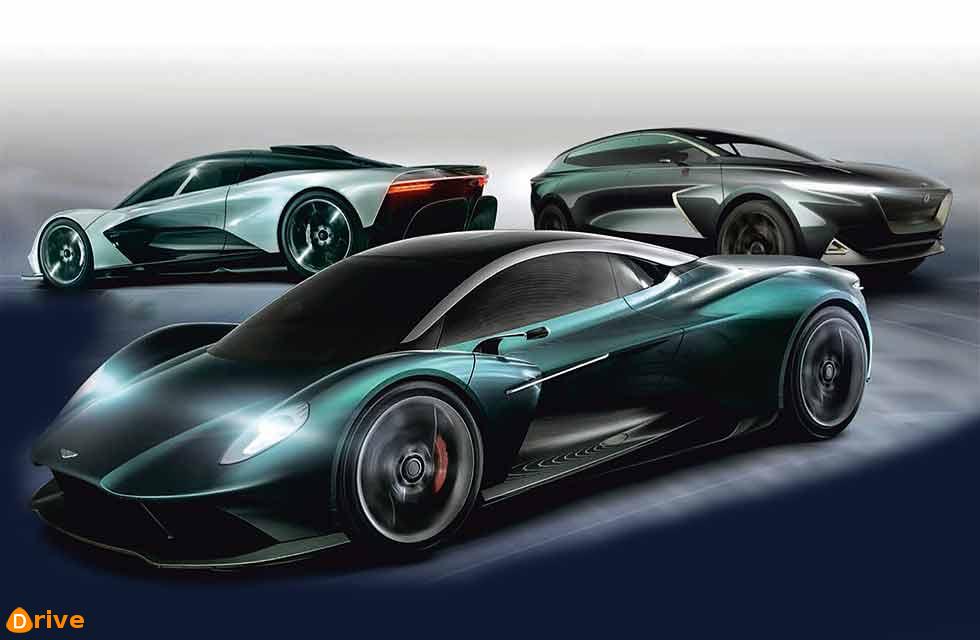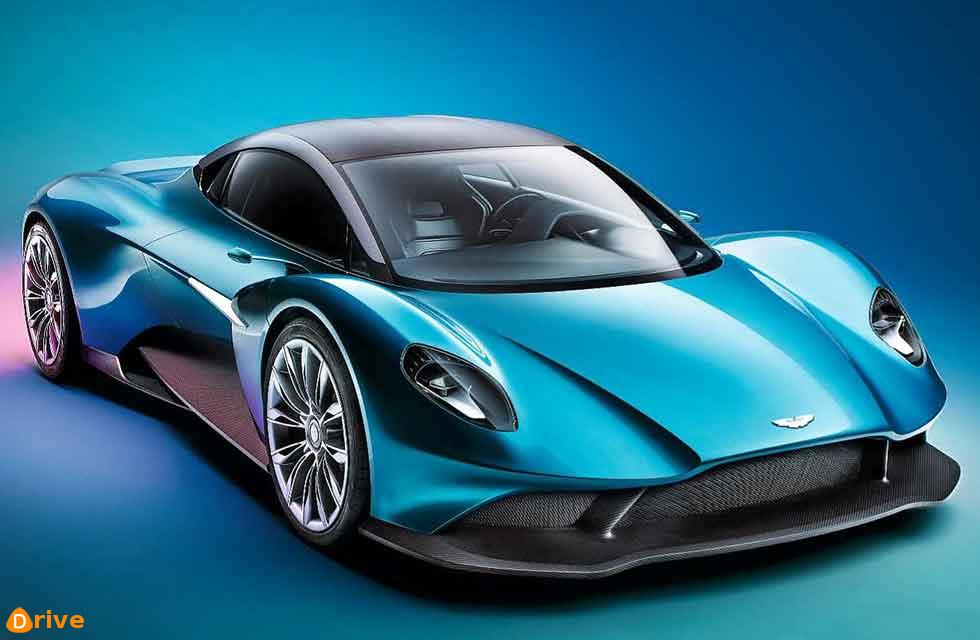Three new Aston show-stoppers. Aston unleashes supercar, hypercar and luxury SUV. Aston Martin has pulled the wraps off a Ferrari F8 Tributo rival, a £1m hypercar and an electric Lagonda SUV at the 2019 Geneva show.
3 ALL-NEW ASTONS Aston stuns the world with two supercars and Lagonda SUV
1 Shock McLaren P1 rival
2 Radical luxury SUV
3 Mid-engined Ferrari slayer
“The concept previews an all-electric Lagonda SUV that will go into production in 2022”

Aston Martin has stunned the Geneva motor show with the launch of three concepts that closely preview all-new production models as its dramatic turnaround plan and range expansion gather pace.
The new cars, which Drive-My received an exclusive preview of before the Geneva show, are a mid-engined supercar called the Vanquish to rival the new Ferrari F8 Tributo, a mid-engined hypercar called the AM-RB 003 offering the next level of performance from the likes of the McLaren P1 and Ferrari LaFerrari, and an electric SUV concept that previews the first production car for a reborn Lagonda.
“The Vanquish will have a new Aston-designed twin-turbo V6 that will be built in the UK”
The Vanquish and Lagonda SUV are the last two models to be shown in Aston’s seven-strong line-up of regular production models under of the ‘Second Century’ plan of boss Andy Palmer. They join the DB11, Vantage and DBS Superleggera, which are all already on sale, and the future DBX and Lagonda saloon, both of which have been previewed with concept cars.
The AM-RB 003, meanwhile, will be a limited-run model that bridges the huge gap between the Vanquish and the Valkyrie. It will be priced from around £1 million. This model, which has been known under the working title ‘Son of Valkyrie’ and co-developed with Red Bull Advanced Technologies, is designed to fast-track Aston’s mid-engined abilities and credibility to support the Vanquish.
VANQUISH VISION CONCEPT
Perhaps the most significant of the new Astons is the Vanquish Vision concept, which closely previews an all-new mid-engined supercar due to start production at Gaydon in 2022. The car marks the first time Aston has put a mid-engined model into series production. It will line up against the next-generation McLaren 720S and new Ferrari F8 Tributo and is likely to be priced at around £250,000.
It also revives the Vanquish name, which was last used on the front-engined GT that the new DBS Superleggera replaced. The car has been in development for two years and has been spearheaded by technical boss Max Szwaj, who joined Aston from Ferrari where he created similar models.

The Vanquish, codenamed AM9, will bring with it a brandnew Aston-designed V6 engine that will be built in the UK.
The engine is twin turbocharged and of an unspecified capacity. Palmer described it as a “little V6 that’s downsized”, with a likely capacity of around 3.0 litres, given the configurations of similar engines from other car makers.
The engine was fired up for the first time in late January. It will also be used in the AM-RB 003, where it will be paired with an electric motor to become a hybrid, a configuration that’s also set to carry over to the Vanquish production car to help with low-end torque. The next-generation 720S, also set to be launched around 2022, will use a downsized V6 hybrid powertrain of its own. Ferrari and Lamborghini are investigating electrified technology, too, marking a notable shift for supercars. Underpinning the Vanquish is a bonded aluminium mid-engined architecture that’s of a new design, inspired by the Valkyrie, but using lessons learned and technical solutions from Aston’s front-engined models as well.
Further technical details of the car have not been released by Aston, but the company will do so as the model progresses from this Geneva show concept car to the full-production model over the next three years. The concept’s styling brings with it dramatic proportions not seen on an Aston before due to its mid-engined layout. It is claimed to be more than 85% representative of the final production car, according to Aston design boss Marek Reichman.
“We do well at taking a concept to reality,” he said. “We do this to state our intentions for the proportions and surfaces. There will be lots of millimetre changes to this, as it’s not something we’ve done before.”
Reichman said inspiration had been taken from the Valkyrie in delivering an aerodynamic shape and surfaces in a beautiful Aston Martin way. “We’ve gone from the insect-like nature of the Valkyrie and played tunes on the surfaces to develop them. The aero isn’t just aero. They’re simple, elegant solutions. Most of the downforce is created under the car,” he said.
Reichman is also keen for the production Vanquish to remain usable every day despite its supercar billing, hence why its aero isn’t as extreme as the Valkyrie’s in compromising aspects such as ingress and egress. “There should be no reason for you not to want to drive it to Sainsbury’s,” he said. “There will be no excuse not to drive it.”
Palmer said the Vanquish has a smaller footprint than it would otherwise have had because of what the company has learned from working with Red Bull Racing’s chief technical officer Adrian Newey.
“One of the real learnings with Adrian Newey is obsession with weight and mass, and package size,” he said. “Our designers are now pushing our engineers. Cars were getting bigger but now we’re heading smaller, with cars packaged around the engine. It’s the reversal of a trend.”
The Vanquish is the “best of what we know” at Aston Martin, said Palmer, and the firm has been laying the groundwork for several years to be able to compete directly with supercar rivals.
“What legitimacy do you have? How do you compete with Ferrari, McLaren and Lamborghini? Since 2016, we’ve been fertilising that field, working with Red Bull in Formula 1, and with Adrian Newey on the Valkyrie to make the fastest production car ever. That’s why we’re also creating 003, to create that legacy and legitimacy for mid-engined cars.
“So that’s the real reason behind F1 and the Valkyrie: to lay the lines of legitimacy for the AM9 [Vanquish].”
Reichman said the Valkyrie’s widespread appeal as the kind of car that extends beyond car enthusiasts will help the Vanquish be recognised as an Aston, and Aston as a maker of mid-engined supercars.
“The Valkyrie is our most looked-at car and it gets ingrained in the psyche,” he said. “It’s an iconic game changer for us with its visual language. Everyone will recognise this [Vanquish] because of Valkyrie.”
AM-RB 003
“If Valkyrie is the best of the best, then the 003 is the best at £1m,” Reichman said of AM-RB 003, a new hypercar that Aston will launch in late 2021. The new model is the second to be co-developed between Aston Martin and Red Bull Advanced Technologies in Milton Keynes and will bridge the sizable gap in Aston’s fast-growing range of mid-engined models between the Valkyrie and the Vanquish.
AM-RB 003 is likely to have more than 1000bhp and the kind of pace that would threaten the Nürburgring lap record. Such positioning and performance would place it alongside next-generation versions of the likes of the P1, LaFerrari and Porsche 918 Spyder, should these three, which were launched in 2013, have been replaced by the time the new Aston arrives.
“AM-RB 003 is likely to have more than 1000bhp and the pace to threaten a Nürburgring lap record”
The model will use Aston’s new twin-turbo V6 engine mated to a hybrid system. The car will be built around a carbonfibre architecture and have carbonfibre bodywork.
“It will have the same principles as the Valkyrie with its all-carbonfibre tub but will be more usable,” said Reichman. The Geneva concept car is 90% representative of the final production model, according to Reichman.

Palmer calls it “the bridge” in the world of mid-engined Aston Martins. “The aerodynamics and tub construction filter down from the Valkyrie to this, and then the new V6 powertrain will go down to the Vanquish,” he said. “The Valkyrie is the fastest production car ever and now we’ve created a son of it that’s a ‘halo’ car above everyone else’s range, like the P1, LaFerrari, and [McLaren] Senna.”
There is further technology transfer from the Valkyrie to AM-RB 003 through the active suspension and electronic systems, with Aston claiming the dynamic brief for the car is to be class leading on both road and track.
Those aerodynamics will not be as extreme as the Valkyrie’s but will in turn be more extreme than on the Vanquish. A big bulk of the aerodynamic work is done under the floor and through the large rear diffuser. AM-RB 003 also adopts aerospace aerodynamic morphing technology with a new variable airfoil called FlexFoil. This alters downforce without changing the physical angle as with an active rear wing and is designed to improve aero performance and reduce wind noise while also virtually eliminating turbulence and drag.
Although AM-RB 003 adopts a look and ethos inspired by the Valkyrie, it does so while being more usable. The doors open out forwards and out of the roof, inspired by an LMP1 car’s, to improve ingress and egress. Unlike with the Valkyrie, there is storage provision for luggage and oddments and a wider centre console to put more space between driver and passenger.
The cabin is unashamedly built around the driver and creates the perfect alignment between the seat, steering wheel and pedals in what Aston calls ‘Apex Ergonomics’, with all major controls aligned for the driver and his or her eye line. Instead of a traditional instrument binnacle, there is a small screen mounted directly on the steering column, with infotainment provided by what Aston calls ‘bring your own’, by simply mirroring a smartphone.
Aston has not quoted any key stats for AM-RB 003 beyond the engine configuration but, as with the Valkyrie and Vanquish, there has been an obsession with weight saving and optimised packaging. For example, all four headlights and tail-lights weigh less than one DB11 headlight and 3D printing is used for parts big and small in the interior, including a centre console that weighs half of what it would using traditional construction methods.
Development of AM-RB 003 will now continue in Milton Keynes, where Aston has a team of 130 people based within the Red Bull Advanced Technologies campus. The site is the home of development for Aston’s mid-engined models. Palmer has previously said AM-RB 003 could also form the basis for an assault on outright victory at Le Mans thanks to a regulation change for 2020 to make the race more aligned to road-going hypercars than the current LMP1 prototypes.
LAGONDA ALL-TERRAIN CONCEPT
This is the second Lagonda concept car unveiled by Aston, after the Vision Concept saloon at last year’s Geneva show. It previews a new Lagonda SUV that will go into production in St Athan, Wales in 2022.
Like the Vision Concept, the All-Terrain Concept is an all-electric car. The two are closely related, sharing an architecture and key components as part of Palmer’s desire for Aston to have greater efficiencies between its models.
The production version of the All-Terrain Concept will line up alongside the likes of the Rolls-Royce Cullinan and Bentley Bentayga when it makes production. However, Palmer thinks the models won’t be competing for buyers due to their wildly different briefs.
“This is a car for tech entrepreneurs, the guys who drive Teslas, not Bentleys and Rolls-Royces,” he said. “It’s in the same high-net worth market but not aimed at the same customer.”
The All-Terrain’s styling is instantly recognisable from the Vision Concept, including the windscreen and side glass that are carried over to further improve efficiencies between the two models. That sleek profile translates here onto an SUV that should have a presence like nothing else on the road, with futuristic styling that Reichman said “challenges, but it works”. He added: “It has to be unearthly and different.”
In migrating from saloon to SUV, the Lagonda has been designed from the roof down rather than the floor up to stop the usual slab-sidedness you get from large SUVs, and to keep the body sleek but also benefit from the raised driving position and greater cabin space and height that an SUV brings. The Lagonda SUV is around 200mm taller than the saloon.
Aston believes that electric power and its packaging benefits are also ideally suited to luxury cars, because this set-up can liberate so much space within the cabin.
“No one has taken advantage of the fact that there is no internal combustion engine,” said Reichman of electric cars so far. “There’s oodles of space in here.”
To that end, the Lagonda SUV concept has an ultra-long wheelbase, with batteries mounted in the floor. This liberates a huge part of the car’s footprint for cabin space. As with its mid-engined models at Geneva, Aston has not confirmed technical specifics of the Lagonda All-Terrain Concept. However, Autocar understands Aston is hoping for an all-electric range of around 400 miles for the production version, with wireless rapid-charging technology fully replenishing the batteries in 15 minutes. The model is set to have all-wheel drive, power coming from an electric motor on each axle. Aston hopes solidstate battery technology will have matured to production readiness by that point to help achieve the roughly 400-mile range in what will be, by its very nature, a large, heavy car needing a sizable battery pack to propel it.
The Lagonda SUV won’t be a proper off-road 4×4 but instead will have what Palmer described as “off-track potential rather than off-road”. The vast four-seat interior is largely shared with the Lagonda saloon concept but trimmed differently, with luxurious materials such as cashmere and crystal rather than more traditional choices to show the different ambience that can be created. The SUV also shares the dramatic rear-hinged rear door openings with the saloon to aid cabin access.
The two Lagonda concepts have the same suspension systems as the upcoming DBX, which will also be built at St Athan from early next year and be Aston’s first SUV.
To that end, Palmer described Aston as ultimately making “seven models from three Meccano sets”. That means close relationships between the front-engined DB11, Vantage and DBS Superleggera; the DBX, Lagonda SUV and Lagonda saloon; and the Vanquish and any other mid-engined specials that Aston makes on top of its core range of seven models.
NOT ONE… NOT TWO… BUT THREE! By STEVE CROPLEY
What hits you like a lightning bolt when you first see Aston Martin Lagonda’s extraordinary trio of Geneva concepts – as we did at the Gaydon HQ just before they departed for Switzerland – is what they say about the company’s extraordinary levels of ambition and energy.
For anyone else, it would be more than enough to propose a brand-new Ferrari F8 Tributo rival for 2022, especially since said Vanquish progresses the genre by a generation. However, at the same time, CEO Andy Palmer and his hyperactive team are unveiling a £1 million hypercar concept (drawing much from the seminal Valkyrie, co-created with Adrian Newey) and an eye-popping Lagonda proposal that takes SUVs in an entirely different direction from the Range Rover, Bentley Bentayga and the rest. Truly, there has never been a greater, more productive era in Aston Martin or Lagonda history. We should settle back and enjoy the ride.
WHY ASTON WILL DESIGN AND BUILD ITS NEW V6 ENGINE ITSELF
“We need a smaller engine and this is a great opportunity to exercise the capability of our engineers here,” said CEO Andy Palmer on why Aston Martin decided to look in-house for its all-new V6 engine rather than source it elsewhere as it had done with its 4.0-litre V8 from AMG.
The last time Aston designed and built its own engine in-house was its old V8, which ended production at Newport Pagnell in 2000. Its current V12 engines are designed by Aston but built by Ford in Cologne.
The twin-turbo V6 will be used by both the Vanquish and AM-RB 003 in production and Palmer has promised that more Astons will use the engine in the future, too. “The engine also allows us to redefine ourselves as an engine builder and one based in the UK,” he said.
However, there’s no word yet on where Aston Martin will build its engines, nor about a long-term future for the Mercedes-AMG V8.
AM-RB 003 and the Vanquish will both use Aston’s new V6.
MID-ENGINED ASTONS: A QUICK GUIDE
Valkyrie
The hybrid hypercar, co-developed with Red Bull Advanced Technologies, will reach first customers later this year. Its naturally aspirated 6.5-litre V12 produces 1000bhp at 10,500rpm and 546lb ft at 6000rpm and its Rimac electric motor 160bhp and 207lb ft. Peak outputs combined are 1160bhp at 10,500rpm and 664lb ft at 6000rpm.
Valkyrie AMR Pro
The Valkyrie road car will spawn a track-only variant under Aston’s new AMR Pro performance sub-brand for its most extreme models. Even more powerful than the Valkyrie on which it is based, the AMR Pro has been made even lighter still and has a target weight of just 1000kg. Only 25 examples are planned to be built of the car that Aston boss Andy Palmer says has “truly mind-bending” performance. AM-RB 003
Previously known as ‘Son of Valkyrie’, AM-RB 003 is a star in its own right. Like the Valkyrie, it uses a carbonfibre tub but will draw its power from a hybrid set-up with an Aston-designed, developed and built twin-turbo V6 at its heart. Greater usability over the Valkyrie is planned. A bid for outright victory at the Le Mans 24 Hours is also possible thanks to a new-for-2020 hypercar-inspired rulebook.
Vanquish
Its three mid-engined big brothers will be limited-run cars, but the Vanquish will be a series-production model in the ‘mainstream’ supercar segment. It will be based around a new bonded aluminium tub and use the V6 also destined for AM-RB 003. Rivals will be next-generation versions of the likes of the McLaren 720S and the new Ferrari F8 Tributo.
Most of Vanquish’s aero is created under the car. Vanquish supercar is due in 2022 priced at about £250,000. Strongly driver-focused cabin has a real cockpit feel AM-RB 003 makes use of aerospace aero morphing tech. AM-RB 003 concept is 90% representative of the production car. Architecture and bodywork of AM-RB 003 are carbonfibre. New Lagonda SUV’s cabin is a retrimmed take on the saloon’s. Lagonda SUV’s bold looks shroud a vast four-seat interior.








